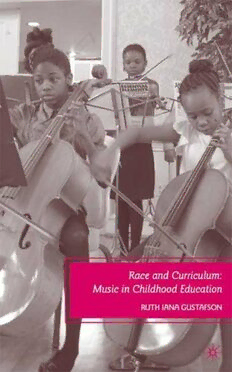
Race and Curriculum: Music in Childhood Education PDF
Preview Race and Curriculum: Music in Childhood Education
Race and Curriculum This page intentionally left blank Race and Curriculum Music in Childhood Education Ruth Iana Gustafson race and curriculum Copyright © Ruth Gustafson, 2009. All rights reserved. First published in 2009 by PALGRAVE MACMILLAN® in the United States—a division of St. Martin‘s Press LLC, 175 Fifth Avenue, New York, NY 10010 Where this book is distributed in the UK, Europe and the rest of the world, this is by Palgrave Macmillan, a division of Macmillan Publishers Limited, registered in England, company number 785998, of Houndmills, Basingstoke, Hampshire RG21 6XS. Palgrave Macmillan is the global academic imprint of the above companies and has companies and representatives throughout the world. Palgrave® and Macmillan® are registered trademarks in the United States, the United Kingdom, Europe and other countries. ISBN: 978-0-230-60840-5 Library of Congress Cataloging-in-Publication Data is available from the Library of Congress. A catalogue record of the book is available from the British Library. Design by Scribe Inc. First edition: July 2009 10 9 8 7 6 5 4 3 2 1 Printed in the United States of America. To my former students and to Duwayne Hoffman, their teacher and mentor The most dangerous and most prevalent illness of our time . . . strikes at our core . . . by which we orient ourselves to take in what we need and close against what is dangerous to us, and most prevalent because everyone is subject to it, more or less. . . . Every exchange with the world is either a match, of mutual benefit, or a mismatch, of advantage to one, and disadvantage to another. —James P. Gustafson, The Great Instrument of Orientation This page intentionally left blank Contents Acknowledgments ix Prelude xi 1 Fabricating the Future Citizen: The Ballads of a Nation 1 2 The Child as Charmed Victim: Early Vocal Instruction and the Social Distinctions Conferred by Disease 17 3 Making Daily Life Sublime: Verse and Rhythm “Never to Abase or Degrade” 35 4 Bacchanalian Chaos, Degenerate Hymns, Public Music Instruction, and the Discursive Fabrication of Whiteness 61 5 Ranking the Listener, Disciplining the Audience 81 6 Goodbye Darwin: Music Appreciation and Musical Publics 103 7 Reason, Ventriloquism, and National Music Memory Contests 123 8 The Listening Body and the Power of the Good Ear 145 9 Aural Icons and Social Outcasts: Beethoven, Lincoln, and “His Master’s Voice” 165 10 Rethinking Participatory Limits: From Music Standards to Hip-Hop 183 Notes 205 Bibliography 239 Index 259 This page intentionally left blank Acknowledgments The energy and resources to pursue this subject came to me when I was a graduate student under the guidance of my mentors and colleagues at the University of Wisconsin–Madison. Much of the research material presented here is based on my PhD dissertation and more recent readings in intel- lectual history and music. I have tried to avoid the formalities of a thesis as much as possible by expanding the field of investigation to subjects I see as vitally related to schools without losing the excitement I experienced when I was with students playing music. For comments on chapters and sec- tions of the book, I am grateful for the keen eyes of Jim Gustafson, whose intellect and endurance are a labor of love and patience; Thomas Popke- witz has been a great friend and mentor on theoretical matters of history writing, the Enlightenment, and its limitations and paradoxes. Julia Eklund Koza, my former thesis adviser, is still, fortunately, an adviser on substan- tive matters in this book and a close friend. I thank her for her labors on my projects over the last decade. Jinting Wu, whom I met through Tom Popkewitz’s Wednesday Group discussions, has been a close friend and source of inspirational courage in her pursuit of the problems of represen- tation of subjects, difference, and the future. Gloria Ladson-Billings, Dory Lightfoot, and Ruth Latham contributed to the formation of my thought with regard to racialism, equity, and equality both through their writing and their personal journeys. Although it is impossible to mention all the writers I have admired in my field, I am especially indebted to the work of Bernadette M. Baker in curriculum history, and the writings of Sylvia Wynter, Joyce E. King, Noah Sobe, Ronald Radano, and Eric Lott on the subjects of nation building, education, race, and music. Friendships I made through the Wednesday Group have meant a lot to me over the years as we not only argued but also shared so many intellectual and personal points of view. For those hours and hours of companionship, I want to thank so many, especially Dory Lightfoot, Marie Brennan, Thomas Popkewitz, Lynn Fendler, and Noah Sobe. I am grateful for support of the Spencer Fel- lowship in Education Program as well. Finally, I want to acknowledge my husband, Jim Gustafson, for his guidance on living through the trials and joys of family while engaged with that other force in my life, academia. Jim has taken this path before me, and from him I have learned how to clear the hurdles and perversities of institutional life while preserving the heart of my convictions.
